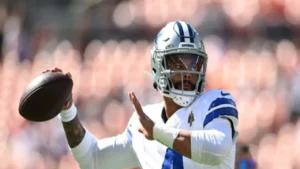Should the Cowboys focus on drafting a new quarterback in the upcoming draft, or continue building around Dak Prescott…
As the 2025 NFL Draft approaches, the Dallas Cowboys face a pivotal decision regarding their quarterback position. With Dak Prescott entering the final year of his contract and a significant $89 million cap hit looming, the franchise must evaluate whether to continue building around their veteran signal-caller or seek a potential successor.
Dak Prescott’s Current Status
Dak Prescott, now 32, has been the face of the Cowboys’ offense since 2016. Despite impressive regular-season statistics, including over 29,000 passing yards and 202 touchdowns, his postseason performance has been a point of contention. With a 2-5 playoff record and no appearances in the NFC Championship Game, questions about his ability to lead Dallas to a Super Bowl victory persist. In 2024, Prescott’s performance was marred by injuries, missing nine games and leading to a disappointing 7-10 season for the Cowboys . These setbacks have intensified debates about his future in Dallas.
Financial Implications
Prescott’s four-year, $240 million extension, signed in 2024, includes four void years, allowing the Cowboys to restructure the deal and push cap hits into the future . However, his $89 million cap hit in 2025 presents a significant financial challenge. Releasing or trading Prescott could free up substantial cap space, but such a move would require careful consideration of the team’s long-term strategy.
Drafting a Quarterback: Pros and Cons
Pros:
- Financial Flexibility: Drafting a young quarterback could alleviate the financial strain imposed by Prescott’s contract, allowing the team to allocate resources to other areas.
- Long-Term Planning: A new quarterback could serve as a developmental project, ensuring the Cowboys are prepared for the future without the need for a high-profile trade.
- Leverage in Negotiations: Having a potential successor could provide leverage in contract negotiations with Prescott, encouraging him to agree to more team-friendly terms.
Cons:
- Immediate Competence: Relying on a rookie quarterback could lead to growing pains, potentially hindering the team’s competitiveness in the short term.
- Team Chemistry: Introducing a new quarterback could disrupt existing team dynamics, especially if Prescott remains on the roster.
- Development Time: Quarterback development takes time, and the Cowboys may not have the luxury of waiting for a rookie to mature while competing in the NFC East.
Building Around Dak Prescott
Despite the challenges, there are compelling reasons to continue building around Prescott. His leadership, experience, and familiarity with the team’s system are invaluable assets. Recent additions, such as wide receiver George Pickens and offensive lineman Tyler Booker, indicate the Cowboys’ commitment to strengthening the roster to support Prescott
Additionally, Prescott’s endorsement of these moves suggests a shared vision between the quarterback and the front office. With a revamped offensive lineup and a renewed focus on team cohesion, the Cowboys aim to capitalize on their existing talent and make a deep playoff run.
Conclusion
The decision to draft a new quarterback or continue building around Dak Prescott hinges on balancing immediate competitiveness with long-term planning. While drafting a quarterback offers potential financial and strategic benefits, it also introduces risks associated with development and team dynamics. Conversely, committing to Prescott provides stability and leverages his experience but requires careful management of financial constraints.
As the Cowboys prepare for the 2025 season, including a high-profile season opener against the Philadelphia Eagles, the front office must weigh these factors to determine the best course of action for the franchise’s .

